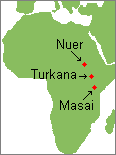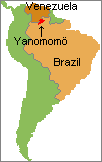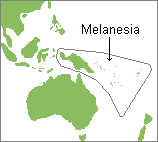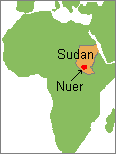Marriage
Rules: Part II
Monogamy, polygyny,
and polyandry
all
have inherent though different types of problems for family members. Not
surprisingly, husband and wife disagreements are common with
monogamy. Parent-child rivalry for the attention
of the other parent is typical also.
With polygyny,
jealousy between co-wives over perceived unequal attention from their shared husband is
common. However, this is often avoided, or at least reduced, by giving each wife a
separate house and a ranked status. The first wife is usually in a commanding
position. Rivalry is also reduced by sororal polygyny
 , which is sisters
marrying the same man. The assumption is that sisters will be more likely to
amicably share a husband. The most disruptive rivalry
in a polygynous family is often between the children, especially if there is
something important to inherit, such as a royal title or wealth. This also results
in rivalry between the mothers. The typical way of avoiding this situation is to
formally define the eldest son or daughter of the senior wife as the heir apparent.
, which is sisters
marrying the same man. The assumption is that sisters will be more likely to
amicably share a husband. The most disruptive rivalry
in a polygynous family is often between the children, especially if there is
something important to inherit, such as a royal title or wealth. This also results
in rivalry between the mothers. The typical way of avoiding this situation is to
formally define the eldest son or daughter of the senior wife as the heir apparent.
With traditional polyandry, the most common source of friction is rivalry
between the fathers and their children for the attention of their wife/mother. This
causes tension for the already heavily burdened wife.
Unusual
Marriage Arrangements
Some
societies are flexible in allowing unconventional marriage arrangements. The cattle
herding Nuer
 tribe of southern Sudan are an example. A woman who is unable to
have children is sometimes married as a "husband" to another woman who then is
impregnated by a secret boyfriend. The barren woman becomes the socially recognized
father and thereby adds members to her father's
patrilineal
kin group.
tribe of southern Sudan are an example. A woman who is unable to
have children is sometimes married as a "husband" to another woman who then is
impregnated by a secret boyfriend. The barren woman becomes the socially recognized
father and thereby adds members to her father's
patrilineal
kin group.
The Nuer also have several
forms of "ghost marriage." A man may marry a woman as a stand-in
for his deceased brother. The children that are born of this union will be
considered descendants of the dead man--the "ghost" is the socially recognized
father. This allows the continuation of his family line and succession to an
important social position. A Nuer woman of wealth may marry a deceased man to keep
her wealth and power. Married Nuer women traditionally have no significant
wealth--it belongs to their husbands. With this form of "ghost marriage",
there will be no living husband, though she may subsequently have children. She is,
in effect, a widow who takes care of her husband's wealth and children until they are
mature.
Second Marriage
Preferences
Many societies have specific
kinds of second marriage rules
that anthropologists refer to as the levirate
 and the sororate
and the sororate
 .
The levirate
specifies that a
widow should marry the brother of her deceased husband (as shown in the diagram
below). The rationale for this rule is that it keeps the dead man's children and
wealth within his family. It also maintains the existing bond between the two
families. The levirate was named after Levi the son of Jacob in the Judeo-Christian
Old Testament. It is a marriage rule that was common in Jewish society several
thousand years ago and in other patrilineal societies that have polygyny.
.
The levirate
specifies that a
widow should marry the brother of her deceased husband (as shown in the diagram
below). The rationale for this rule is that it keeps the dead man's children and
wealth within his family. It also maintains the existing bond between the two
families. The levirate was named after Levi the son of Jacob in the Judeo-Christian
Old Testament. It is a marriage rule that was common in Jewish society several
thousand years ago and in other patrilineal societies that have polygyny.
The Price
of Marriage
The marriage process often
involves a predetermined agreement to transfer wealth or to perform labor for one's
in-laws. In the mostly monogamous societies of Europe and Asia, this traditionally
has been in the form of a dowry, which is money or property given by the bride's
family to the groom, ostensibly to establish a new household
or estate. It is, in a sense, her
share of the family inheritance. Dowries may be seriously negotiated, especially
when the bride's family is wealthy. Until the early
20th century in Europe, rich
families commonly hired lawyers do draw up formal marriage contracts that often specified the dowry
details. The North American traditions of the "hope chest" and the bride's
family paying for the wedding are survivals of a dowry system.
In India today, the failure
to pay all of an agreed upon dowry amount is considered an
extremely serious problem. It places
a newly married young woman in a difficult and dangerous position in the home that
she shares with her husband's family. Hundreds of these brides
die each year in what are euphemistically referred to as "kitchen
accidents." In fact, some are killed by the husband, mother-in-law, or other
members of his family who view the failure to pay the agreed upon dowry as being a breech
of contract and the ruining of his life. The death of his "failed" wife
allows him to marry again and to obtain the dowry that his family believes he deserves.
Bride price (or
wealth) is the reverse of a dowry. It involves the groom giving things of high
value to the bride's father. Bride price is most common among polygynous,
small-scale, patrilineal societies--especially in
sub-Saharan Africa and among Native
Americans. When European missionaries first encountered bride price, they
misinterpreted it as being nothing more than a demeaning "bride purchase."
It actually is a way of showing respect for the bride and her parents. At the same
time, it is a compensation for the bride's family for the loss of her economic
services. Very importantly, it is also a way of validating the groom's right to
future offspring. In some societies, children are not "legitimate" if
their father did not pay a bride price. It is more
important than a marriage ceremony is establishing legitimacy.
Often the bride price is large enough to require kinsmen
to help the
groom in making the payment. This is especially common among pastoralists societies,
such as the cattle herders of East Africa who have traditionally paid bride price with
cows. Among tribes like the Nuer, Turkana, and Masai, borrowing to make up the
agreed upon bride price puts the groom in debt to his older male relatives for many
years. The bride's father usually disburses the payment in turn as bride price for
his sons and nephews. As a result, the community's wealth is circulated.
 |
|
 |
|
Masai mother and child |
Among these tribes, the
bride's family has a strong economic interest in keeping her marriage together because a
divorce would require the return of the bride price, which often has already been given
away to relatives. If there are children, however, the bride price usually does not have to be
returned, but they belong to the groom's family. He keeps the children instead of
the bride price. In a sense, the bride price becomes a payment for children and,
therefore, has also been referred to as "progeny price"
 .
.
 |
|
|
| |
 |
In societies with little material wealth and social
rules requiring sharing, it is rarely possible to accumulate a bride price. As a
result, such societies often have bride service instead. The groom agrees to
work for his in-laws for a set period of time. Among the Yanomamö and other
lowland forest peoples of South America, this service may go on for years. Making it
more difficult is the fact that Yanomamö men are customarily prevented from speaking directly
to their in-laws and must avoid them.
In
Melanesia
 , the Amazon Basin of South America, and scattered
elsewhere among warlike peoples, there have been cultural patterns allowing
marriage by
capture as an alternative method of acquiring a wife. It has occurred usually
when bride price could not be arranged or when women were in short supply. It is a
mistake to assume that marriage by capture is always a forceful act on an unwilling
woman. At times, it is merely a ritual or a cover for a prearranged elopement.
, the Amazon Basin of South America, and scattered
elsewhere among warlike peoples, there have been cultural patterns allowing
marriage by
capture as an alternative method of acquiring a wife. It has occurred usually
when bride price could not be arranged or when women were in short supply. It is a
mistake to assume that marriage by capture is always a forceful act on an unwilling
woman. At times, it is merely a ritual or a cover for a prearranged elopement.
NOTE: In
contemporary Japan there is a system of traditional gift exchanges between the
groom's and the bride's families that does not neatly fit the usual definition
of a dowry or a bride price. They have essentially combined both
patterns in a largely symbolic gift exchange. When a couple becomes
engaged, the two sets of parents formally exchange betrothal gifts with each
other, thereby reinforcing that the marriage will be a bond between the
families rather than just the young couple. In the Tokyo
region, these "yuino" gifts usually consist of nine items that are considered to be
auspicious (e.g., abalone, dried bonito, dried kelp, etc.). During this
ceremony, the groom also gives "yuinokin" (betrothal money) to his future
bride's family. It is understood that this money is to be used in
establishing a household for the newly wed couple. During the late
1990's this betrothal money averaged 878,000 yen (a little
more than $7,300 U.S. dollars at
the time). It is popular for urban Japanese couples to design their
own wedding rituals and to incorporate North American traditions (e.g., white
wedding dresses, tiered wedding cakes, etc.). It is also very popular to
get married in Hawaii and other places outside of Japan. For more
information about contemporary Japanese marriage traditions see
"Marriages of
Convenience" and "What
is the Ideal Marriage."
![]() , which is sisters
marrying the same man. The assumption is that sisters will be more likely to
amicably share a husband. The most disruptive rivalry
in a polygynous family is often between the children, especially if there is
something important to inherit, such as a royal title or wealth. This also results
in rivalry between the mothers. The typical way of avoiding this situation is to
formally define the eldest son or daughter of the senior wife as the heir apparent.
, which is sisters
marrying the same man. The assumption is that sisters will be more likely to
amicably share a husband. The most disruptive rivalry
in a polygynous family is often between the children, especially if there is
something important to inherit, such as a royal title or wealth. This also results
in rivalry between the mothers. The typical way of avoiding this situation is to
formally define the eldest son or daughter of the senior wife as the heir apparent.
![]() tribe of southern Sudan are an example. A woman who is unable to
have children is sometimes married as a "husband" to another woman who then is
impregnated by a secret boyfriend. The barren woman becomes the socially recognized
father and thereby adds members to her father's
patrilineal
kin group.
tribe of southern Sudan are an example. A woman who is unable to
have children is sometimes married as a "husband" to another woman who then is
impregnated by a secret boyfriend. The barren woman becomes the socially recognized
father and thereby adds members to her father's
patrilineal
kin group.![]() and the sororate
and the sororate
![]() .
The levirate
specifies that a
widow should marry the brother of her deceased husband (as shown in the diagram
below). The rationale for this rule is that it keeps the dead man's children and
wealth within his family. It also maintains the existing bond between the two
families. The levirate was named after Levi the son of Jacob in the Judeo-Christian
Old Testament. It is a marriage rule that was common in Jewish society several
thousand years ago and in other patrilineal societies that have polygyny.
.
The levirate
specifies that a
widow should marry the brother of her deceased husband (as shown in the diagram
below). The rationale for this rule is that it keeps the dead man's children and
wealth within his family. It also maintains the existing bond between the two
families. The levirate was named after Levi the son of Jacob in the Judeo-Christian
Old Testament. It is a marriage rule that was common in Jewish society several
thousand years ago and in other patrilineal societies that have polygyny.




